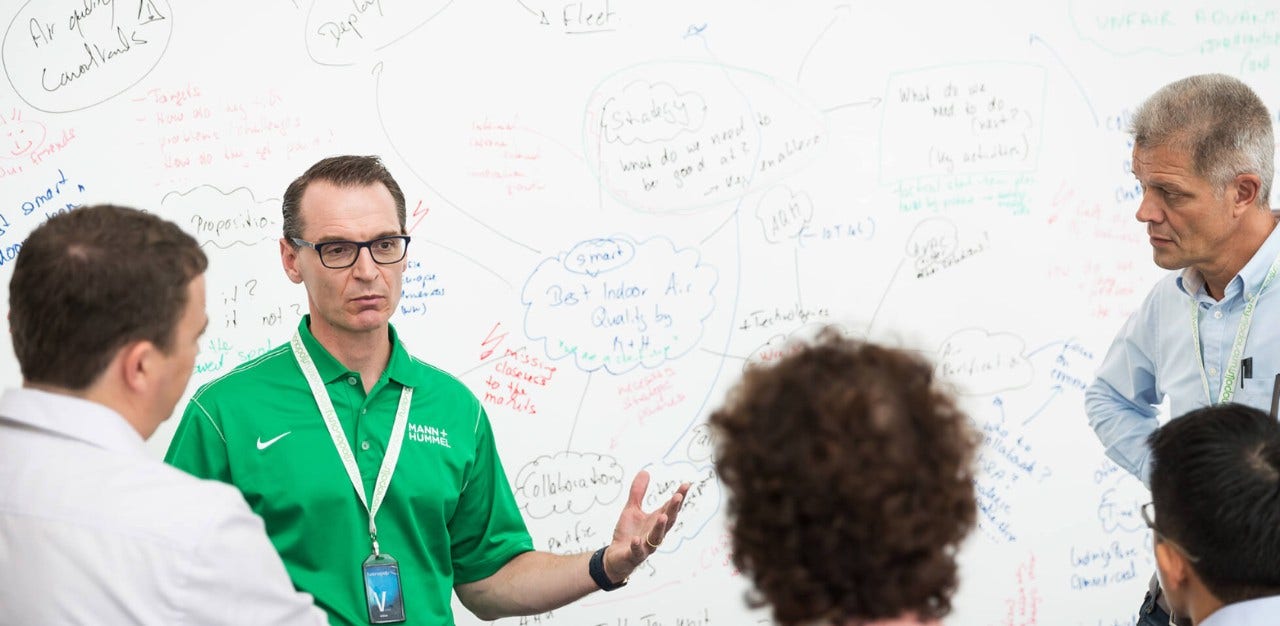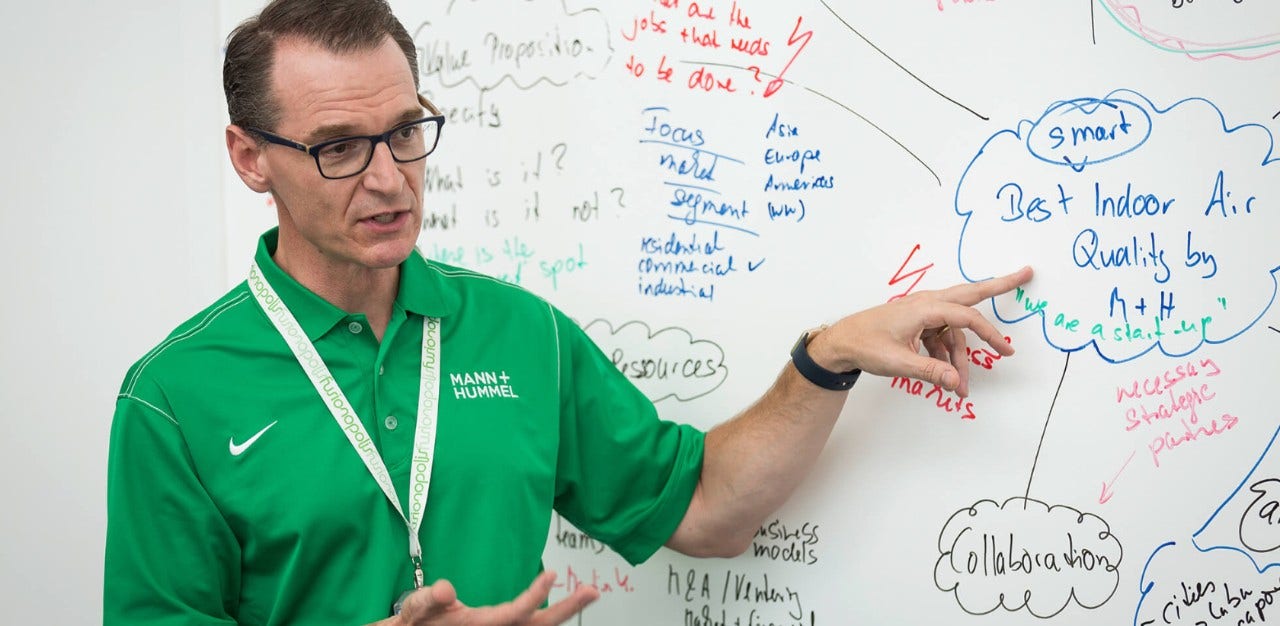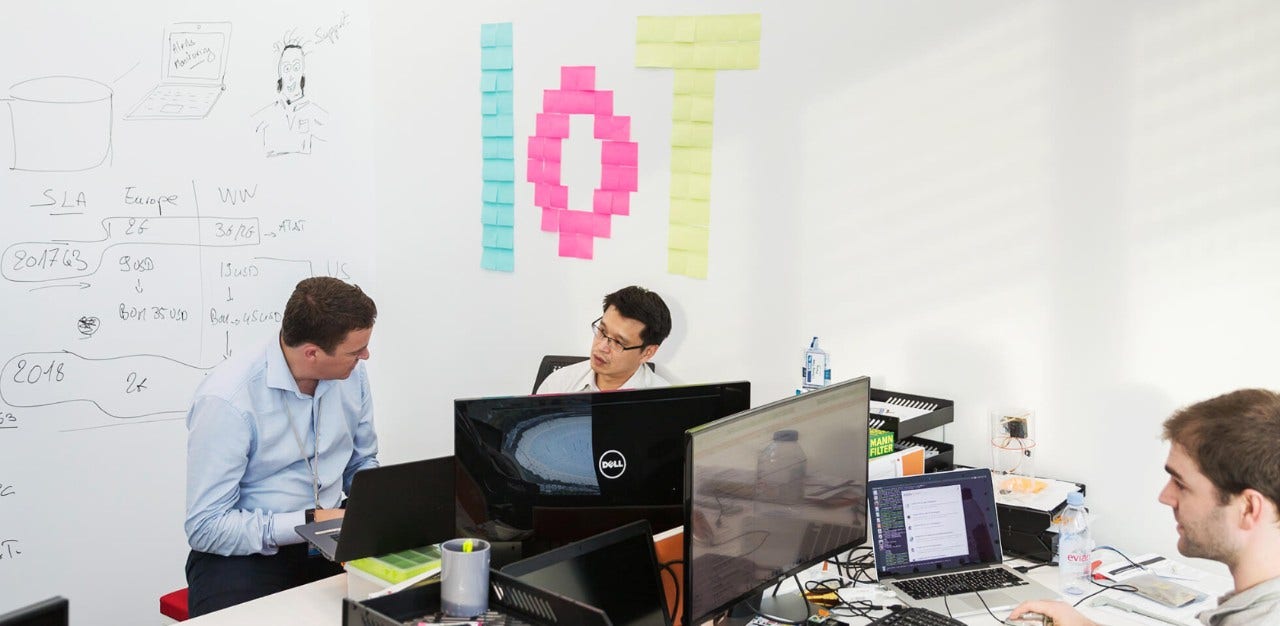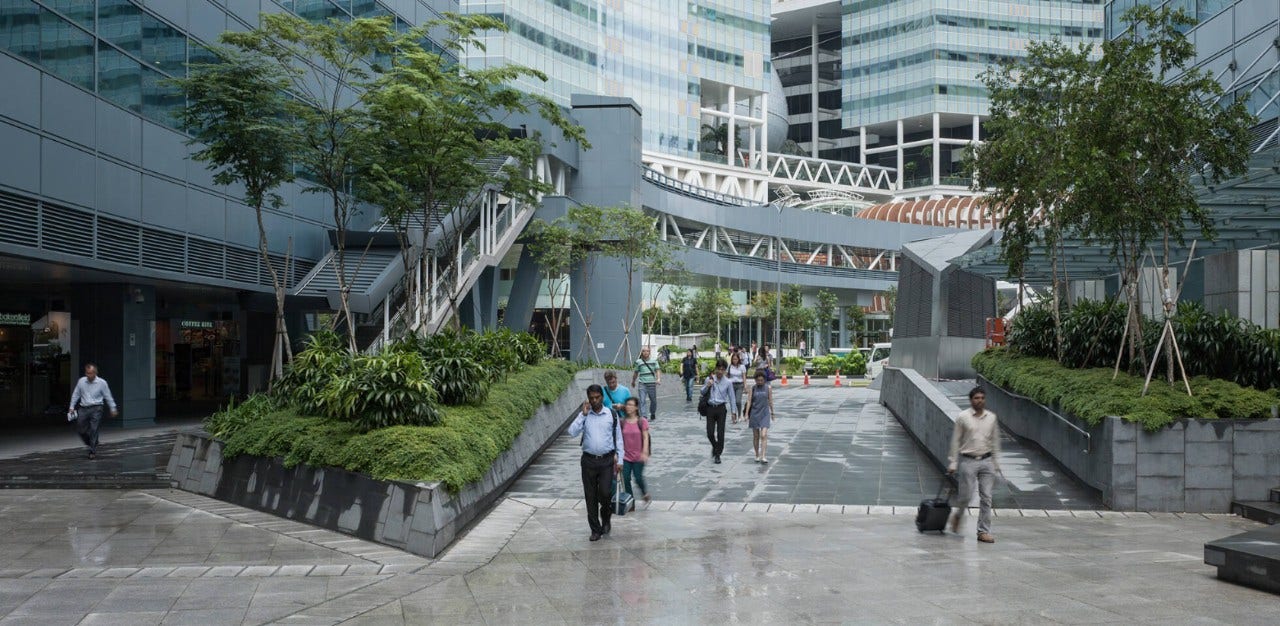Internet of Things: The MANN+HUMMEL IoT Lab in Singapore
IoT Lab of MANN+HUMMEL

The Internet of Things (IoT) Lab of MANN+HUMMEL which was opened in October 2016 is located in the heart of the vibrant metropolis of Singapore. The focus of the team's daily work is the future-oriented development of intelligent, networked solutions in the area of filtration.
The view is breathtaking on level 11 of the Fusionopolis tower in the center of Singapore on this day of March 20, 2017. In the distance it's possible to make out the colorful facilities of the botanical garden. In the nearby park runners run undisturbed, and in the square in front of the Fusionopolis which is where the start-up companies are concentrated there is some hustle and bustle. Grass verges add some color to the somewhat somber effect of the high-rise buildings where numerous offices are hidden behind glass facades.
This is where, at the promising address Fusionopolis Way No. 3, the MANN+HUMMEL Internet of Things Lab team managed by Director Ping Kian Bee works. Bee enters the modernly equipped open-plan office where his desk is also located. At this moment, some employees are in a video conference reporting on the progress of a project, and others are involved in lively discussions in front of a whiteboard filled with writing. "It's rarely quiet round here", laughs Bee. He is wearing black cloth trousers and a light blue shirt, no tie, no jacket. The atmosphere is relaxed in the MANN+HUMMEL IoT Lab. "We feel a little bit like a tech startup here in the company. That has surely to do with the subject and material of our work."
The Internet of Things is omnipresent also at MANN+HUMMEL
Ping Kian Bee was director of the IoT Lab in Singapore until the summer of 2017. In the meantime, he has taken on the job of Technical Director at Intelligent Air Solutions Asia. In this position he works closely together with the IoT Lab. In our interview Bee talks about the work with his team in Singapore.
What is the objective of the IoT Lab?
Ping Kian Bee: The objective of the IoT Lab is to develop intelligent technology for the market which supports and complements our current solutions. MANN+HUMMEL has excellent expertise in the areas of mechanical engineering and filtration. We believe that with the aid of the digital transformation we can further strengthen our market position.
How does the IoT Lab work?
Ping Kian Bee: To a certain extent, we work in a way similar to a startup. We are a small team which is networked to all the business units and worldwide locations of MANN+HUMMEL. Therefore, we have to be flexible and agile and also maintain this agility when we implement our projects. We always have the customer and his requirements in our minds.
Where does the inspiration for the projects come from?
Ping Kian Bee: We are open to the world and the changes in society. As a result, we exchange ideas with many external partners. These could be startup companies, academics or big technology groups. This enables us to participate in their portfolio and ideas and thus to further develop our own ideas. The highly networked multicultural location of Singapore with influences from all over the world is an additional inspiration.
Total networking
The subject that Bee is talking about is called IoT, the Internet of Things. IoT describes the networking of objects with the internet to enable these to communicate independently, pass on data to the user or to enable an object to carry out a task. The range of possibilities includes, for example, fridges which order food on their own account, mobile phones which control lights and heating systems, and also self-driving cars. According to a study carried out by the US-American company Business Insider, up to 2020, there will be around 24 billion objects connected to the internet worldwide, which is roughly four devices per person. In the same time period, there will also be a further ten billion smartphones which will further extend the application possibilities of IoT.

This is a development with a fast pace which society and companies, as service providers or industrial companies, have already been faced with for some time. "The world is turning extremely quickly, and we cannot stop this process. This means there are two options: We can either close our eyes to ignore what is coming, or we can take on an active role to establish a leading position also in this area", emphasizes Bee.
MANN+HUMMEL has an open mind and has therefore set a clear objective for its IoT Lab with regard to its digitalization strategy. "We would like to develop intelligent technology to exploit our existing expertise to further expand our position as market leader in the area of filtration", explains Bee. In his opinion, the concern that digital technology could make existing products redundant is without foundation. "We believe that digital technology will strengthen and complement our capability in the area of mechanical engineering and filtration. We do not want these areas to work against each other, but rather that they become more integrated."
For this reason, Bee and his team of seven are working on more than just one isolated IoT solution. They are considering a whole range of solutions starting with sensors via interfaces which also include cloud solutions, with the result that the team is engaged in a very broad range of activities. "Our work is designed to enable the individual business units at MANN+HUMMEL to develop new solutions. As well as considering our traditional areas of activity such as the automotive industry or industry in general, we are also working intensively on trends in society and their effects on our daily lives", explains Bee.

One of these trends in society is the increasing amount of air pollution. The World Health Organization (WHO) estimates that as a consequence 80 percent of the world's population is affected by air pollution which exceeds the recommended safety limits. Media reports of smog and pollution alerts are becoming more frequent and not only for Asian megacities such as New Delhi or Beijing, but also for cities all over the world ranging from Stuttgart to Cape Town or from Los Angeles to Moscow. According to the WHO, on average more than three million people die every year from air pollution. It is worthy of note, however, that with the harmful substances which are also found in buildings, the pollution level in closed rooms is partly many times higher than the levels in outside areas. This is where the strategic initiative OurAir comes in, one of the key projects of the IoT Lab. With these and other similar projects, MANN+HUMMEL is pursuing a path where the end consumer comes into more direct contact with the company's products than previously was the case.
Diverse expertise
Ping Kian Bee elaborates on the subject. "The point we always have to consider is: What problem do we want to solve for the customer? The product or the service is only the means to fulfil a certain task. For example, most people are not interested in how an air cleaner looks like. But they are very interested in breathing in clean air. If we really focus on the customer and his requirements to find out how he lives and what he expects, we are able to make an even better promise for performance. This is what I and my colleagues are working on intensively."
The team around Bee is made up of system, hardware, firmware and software engineers and data specialists. They come from Australia, China, India and Singapore. Bee himself is from Singapore and has extensive experience in the management of technology roadmaps, the programming of platforms and system architecture, in particular in the area of smart TV, lighting and consumer electronics. He joined MANN+HUMMEL recently, in February 2017. The diverse expertise in the IoT Lab also benefits from the continuous exchange of information with business units and locations. The IoT team knows what is going on at MANN+HUMMEL around the world and which issues are on the agenda at the respective locations. "Our thirst for information is unlimited. Therefore, there are no boundaries to our activities", emphasizes Bee.

This is also indicated by the number of projects the IoT team is working on. In the meantime, more than ten innovation projects have been implemented, and 30 further projects are in the pipeline. In addition, there are joint ventures with external partners. These already include seven partnerships between the MANN+HUMMEL IoT Lab and established technology suppliers and startup companies. "The cooperation with external partners enables us to get closer to the subject of innovations. It gives us valuable perspectives and helps us to be more creative and develop new ideas", stresses Bee.
Here the exchange of information with colleagues or external partners is seldom made in person. In fact, it is video conferences, intelligence services or Skype sessions which allow the cooperation across borders on a day to day basis. "We are part of a big virtual team", explains Bee. The buzzword here is also networking. MANN+HUMMEL selected Singapore as a location because the level of networking capability here is perhaps higher than anywhere else in world. 5.5 million people live in the metropolis on the Malaysian peninsular. The four official languages of the city state with the impressive skyline are English, Malaysian, Mandarin and Tamil, and every year, roughly eleven million tourists find their way to Singapore. The unemployment rate of just 2 percent in Singapore is one of the lowest in the world. Along with Hong Kong, the city is one of the most important financial centers in Asia. Numerous companies are located here, which, according to the German foreign ministry, include more than 1,500 German companies.

Melting pot between the East and West
This is understandable, according to Ping Kian Bee. "Singapore is a great city, a mix of the East and West. There are many advantages of such a cultural melting pot, and we can benefit from the different perspectives. We have the influences from Asia, and these are complemented by the influences of Western companies which have an extensive range of technology to offer. And this is all at one location."
He takes a look at the impressive scenery visible through the window of his office, which in the meantime is empty. The sun has now gone down completely, the street lights are shining brightly in the dark and encapsulate the buildings in warm light. Only one or two windows across the way remain illuminated, and also Bee's working day is slowly drawing to a close. "Due to the different time zones, it is naturally not always easy to integrate all the colleagues around the world", he explains. "We usually organize our meetings to involve as many MANN+HUMMEL colleagues as possible. Consequently, we sometimes have to stay a little longer in the office, and the US colleagues have to get up earlier. These are the small disadvantages of global cooperation which an international company has to come to terms with." Bee shrugs his shoulders with a laugh and has a quick look at his smartphone.
Occasionally, for example on holiday, he gives himself and his family a few days of rest and enjoys complete isolation from the digital network. "Sometimes that's good for me. But it's difficult for me to hold out long without technology. I want to know what's developing." And he adds: "And naturally, what's developing at MANN+HUMMEL." Ping Kian Bee winks knowingly. One thing is clear: the process of digitalization is in full swing, and MANN+HUMMEL is well prepared – in the IoT Lab and around the world.